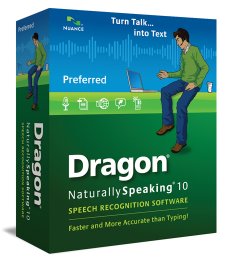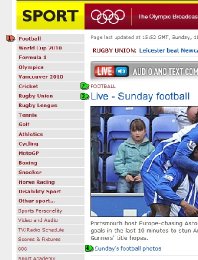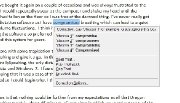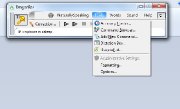Dragon NaturallySpeaking 10: Preferred Edition
As a high-level tetraplegic (or quadriplegic if you prefer, the two terms are interchangeable), I have been dependent on other people to use the computer since my accident nearly 15 years ago. I've tried various methods including a trackerball and have recently experimented with an IntegraMouse and a system where a small sticker is placed on the user's forehead or nose and a device on the top of the monitor follows the slight head movements to move the mouse around the screen. I found these extremely tiring and couldn't imagine using them for any length of time as typing was extremely slow and frustrating.
I first used Dragon Dictate back in 1995 when the program cost £500 and tried it in the occupational therapy department at the spinal injuries unit in Hexham and, when I moved to the spinal injuries unit in Southport, splashed out on the software only to find it extremely slow, irritating and tiring. With previous incarnations of Dragon Dictate, the training processes involved hours of repeating the police alphabet and dictating phrases over and over again to get the software used to your voice.
It was therefore with some trepidation that I was convinced to pay out 90 quid for Dragon NaturallySpeaking and give it a go. In the period between using Dragon Dictate and buying Dragon NaturallySpeaking, the only dictation software I had used was the free software that came with Vista and Windows 7. I found this to be pretty good at times but terrible at others so, hoping that it was a case of that you get what you pay for, I bought Dragon and had it installed so I could begin what I thought would be another long and torturous training process.
The good news is that nothing could be further from my expectations as all that Dragon NaturallySpeaking needs is about 15 minutes of your time in which you read out parts of the text on screen and it picks up the inflections in your voice. This is necessary when there is no selection of accents apart from saying whether you're from Southeast Asia, Australia, Britain or the United States! A fairly broad spectrum I think you'll agree. I was already suspicious and the brevity of this process made me sceptical that the program would be able to pick up my commands and be far from accurate at translating my voice into words. I was pleasantly surprised when the first time I tried Microsoft Word, the accuracy level was very high and any errors were very quick and easy to correct.
If the program gets a word wrong, all you need to say is correct followed by that word and choose from a list of five options (there can be more or less by altering the options) and if the words is not there, simply say 'spell that' and you can either type in the word or dictate it letter by letter. With this option, you can use the police alphabet (alpha, bravo, charlie etc.) or just simply say the letters as you would normally -- it's that easy. I found it very easy to edit text in a Microsoft Word document such as selecting some text and either italicising, bolding or underlining words, navigating around the page and cutting and pasting text.
When it comes to browsing the Internet, some commands work better than others such as go through your favourites list or picking out certain headlines on the window but when this fails the mouse grid system works very well at narrowing down where you want the mouse to point. Of course, most people will use the mouse is well as the dictation option, choosing to dictate text while sitting in front of a computer with a mouse and keyboard. When you're surfing the net, it is easy to select which link you want to click on ads a command like 'football' will bring up several numbered tabs and you just select the one which you want to see by saying that number.
The system comes with a variety of modes so you can select pure dictation which negates command options to delete text so saying 'scratch that' will type just that and not delete the words you just said. You can also have command mode which will give you control over the mouse but completely remove any dictation option. For the time I've been using this, I've had it on normal mode and this will be the default option for most people, allowing both dictation and command options and will especially be useful if you can use the mouse or keyboard to rectify small mistakes. Something which I probably won't use but others may, is Dragon NaturallySpeaking's to transcribe recorded audio files from a dictaphone. This is ideal for someone who is away from their computer but wants to get something down and recorded without having to write it down; all you do is treat the dictaphone as your computer and talk to it then have the audio file translated into text to edit at your leisure.
There are different versions of this program (Standard, Preferred and Professional; I'm using Preferred) that offer different things. Standard offers the basic dictation with some command functions whereas Preferred has more shortcut commands and the ability to use a Bluetooth headset. Professional has so many more capabilities such as the option to search your calendar, browse the desktop and have unlimited users -- the others are restricted to one user. Professional also cost a great deal more so will not even be considered by most home users.
The physical package comes with a wired headset although there is the option to upgrade to a Bluetooth headset for about £50 more with Preferred or Professional and this is on top of the range microphone that retails separately for over £60. As I always sit in front of my computer or lie next to it in bed, the cable isn't an issue so I don't really need Bluetooth. If you're the sort of person who literally likes to think on their feet and walk around whilst talking then the Bluetooth headset will be a great help to you as it doesn't matter where you are in your office or in your home, you can talk to the program and give dictation from anywhere.
All in all, Dragon NaturallySpeaking 10 shows how far along dictation software has come and given my past history with this type of software and the fact I'm talking with artificially controlled breathing and a retainer in my mouth (as I'm undergoing orthodontic treatment) which gives me a slight lisp, shows just how good this program is. Dragon promised so much nearly 15 years ago and it seems, with this program, but they're finally delivered.
This will be of great help to people who aren't great at typing, struggle with repetitive strain injury, or have another reason, like mine, for not being able to type very well or even at all.
It is probably worth mentioning that this entire review has been written via Dragon NaturallySpeaking and I haven't needed a typist here to correct mistakes, navigate around the document or add any words. I think this speaks for itself is a testament to just how far dictation software has come.
If you want to check out the differences between the three versions, go to the website at http://www.nuance.co.uk/naturallyspeaking/.







































Your Opinions and Comments